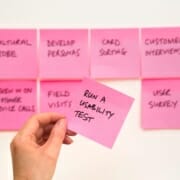7 Steps to Prepare for a Successful App Launch
In 2021 alone, consumers downloaded a total of 200 billion apps. The rising trajectory of mobile app adoption reveals immense interest among consumers for new exciting apps. However, this doesn’t mean you can create an app in weeks, relax and hope for revenues. Launching an app requires an understanding of market trends and a lot of effort.
Below we go through the different phrases of successful app launch.
1. Define Goals and KPIs
After defining a market proposition and building an app that fulfills a specific need, now it’s time to launch your new product. Start by defining clear goals and key performance indicators KPIs for your application.
It’s easier to identify your app’s strengths with sufficient information about your market and buyer persona. And with specific metrics in place, you can determine if your app’s launch is a success, or you can conduct productive usability testing to eliminate any obstacles before your app gets to the end-user.
2. Prototype Testing
It’s crucial to test your app right away. It’s a great solution to have a QA engineer review your app from inception to completion and evaluate it throughout and before it’s launched. And when the prototype is ready, you should submit it to your sampled representatives for honest review and feedback about usability and functionality.
3. Build Buzz
The next step is to build a landing page and collect emails. A simple one-pager landing page with an email field is adequate. Collect emails and ask for subscriptions. It’s advisable to compile a list of early adopters and engage them before launching.
4. Make Specific Plans
After going through any possibilities, gathering relevant information, building and testing your app, now it’s time to determine the app’s launch date. Your target audience must know exactly when to expect the finished product. This step presents an excellent time to build a marketing plan that covers your distribution channels, the timeline, and the message you’ll convey.
5. Beta Release
Create a contained release to show how the actual product will act in the real world without risking the app’s performance. This research must be specific and must confirm that every functionality is intact. You can leverage these actionable insights to get closer to the launch date. These insights provide you with the meaningful feedback you need for a successful launch.
6. Select Launch Platform
You should select stores that your app will be available on based on your choice of technology or development. Go through the approval process and set the launch date. Each mobile app store has requirements, rules, and policies when publishing your app. Carefully review all the details and prepare your app for publishing by complying with the set requirements. A crucial part of this preparation involves creating a description and high-quality videos and screenshots to showcase. If you adhere to the guidelines given in each store, you will encounter no problems publishing your app right away.
7. Launch Date
Although the launch date is the most exciting part of the app development process, it should come easy with all the steps you’ve done before. Make use of all the materials you’ve used along the way and make a push through the available channels. Whether you’ve opted for PR articles or social media influencers, the goal is to make the “call-to-action” for download as visible as possible.
- Post-Launch Tracking. After the launch date, keep tracking performance to get an idea of how the launch was and if it met your key performance indicators KPIs.
- React on feedback. The feedback and insights you obtain from your audience are only valuable if you act on them. Try fixing bugs, testing performance updates, and implementing new functionalities that your users recommend.
Contact NS804 for mobile app development (and launching) solutions.

 https://www.pexels.com/photo/person-holding-silver-android-smartphone-50614/
https://www.pexels.com/photo/person-holding-silver-android-smartphone-50614/









 https://unsplash.com/photos/Ox6SW103KtM
https://unsplash.com/photos/Ox6SW103KtM
Leave a Reply
Want to join the discussion?Feel free to contribute!